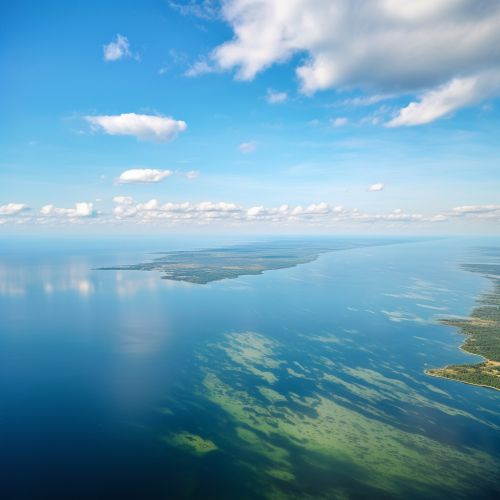Lake Erie
Geography
Lake Erie, the fourth largest of the five Great Lakes of North America, is located in the eastern part of North America. It is bounded on the north by the Canadian province of Ontario, on the south by the U.S. states of Ohio, Pennsylvania, and New York, and on the west by the state of Michigan. The lake is approximately 241 miles (388 km) long, 57 miles (92 km) wide at its widest point, and has a surface area of about 9,910 square miles (25,667 square km).


Hydrology
Lake Erie is the shallowest of the Great Lakes, with an average depth of 62 feet (19 meters) and a maximum depth of 210 feet (64 meters). It has a water volume of 116 cubic miles (483 cubic km). The lake's primary source of water is the Detroit River, which connects it to Lake Huron. It drains via the Niagara River into Lake Ontario. The lake's water levels fluctuate seasonally and are regulated by the International Joint Commission.
Climate
The climate around Lake Erie is classified as humid continental, characterized by four distinct seasons. The lake significantly influences the weather of the surrounding region, creating a phenomenon known as the "lake effect". This results in increased cloudiness and precipitation, particularly snowfall, during the fall and winter months. The lake also moderates temperature extremes, making the surrounding area warmer in winter and cooler in summer compared to regions further inland.
Ecology
Lake Erie supports a diverse range of aquatic and terrestrial ecosystems. Its warm, shallow waters are home to numerous species of fish, including walleye, yellow perch, and smallmouth bass, making it a popular destination for recreational fishing. The lake also supports a large population of waterfowl and is an important stopover site for migratory birds. The surrounding land areas consist of a mix of forests, wetlands, and agricultural lands, providing habitat for a variety of wildlife.
Human Interaction
Human interaction with Lake Erie has been extensive. The lake has been a major transportation route since the time of European settlement, with numerous ports along its shores. It is a significant source of drinking water for millions of people in the surrounding region. The lake is also a popular destination for recreational activities, including boating, fishing, and swimming. However, human activities have also led to environmental challenges, including pollution and invasive species.
Environmental Challenges
Lake Erie faces several environmental challenges. Industrial and agricultural runoff has led to nutrient pollution, causing harmful algal blooms that threaten water quality and aquatic life. The lake is also affected by invasive species, such as the zebra mussel and the round goby, which disrupt the ecosystem and impact native species. Efforts are underway to address these issues, including pollution control measures and invasive species management.
